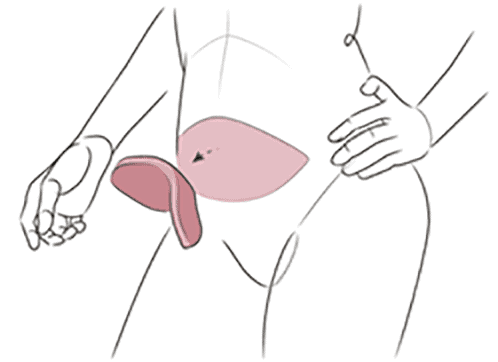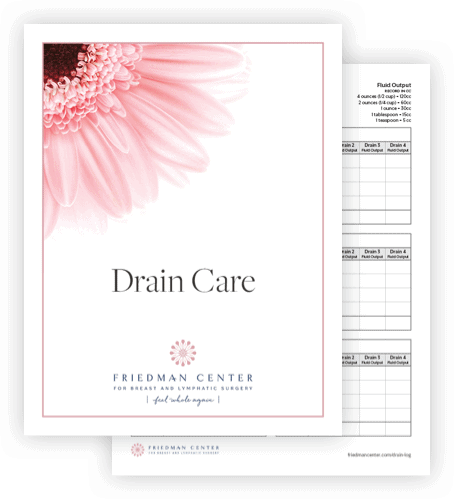Drain Care After
Breast Reconstruction
Proper drain care is an important part of your postsurgical recovery.

After your breast reconstruction, you’ll have one or more Jackson-Pratt (JP) drains to help carry fluid away from your surgical sites.
Once you’re discharged from the hospital, you’ll need to maintain and empty your drains as well as record drainage fluid to ensure that your recovery is on track.

Instructions for Postsurgical Drain Care
Emptying the Drains
During recovery, you’ll need to empty your drains twice a day.
First, wash your hands with warm water and soap.
Next, detach the drainage bulb and unplug the stopper. Pour the fluid from the drain into a measuring cup.
Squeeze the air out of the bulb and replug the drain, reattaching it to your bra or clothing as needed.
Recording Drain Fluid
Each time you empty your drain, record the color and amount of fluid on your drainage chart. Be sure to include the time you emptied your drain as well.
Use the Drain Log in this packet for an easy reference. You’ll want to share this information with your surgical care team.
Milking the Drains
You’ll need to milk your drains regularly to prevent clogging. You should do this before you begin emptying your drains and anytime you notice fluid leaking around the insertion site or see clots in the tubing.
First, wash your hands with warm water and soap.
Pinch the tubing with your thumb and index finger close to the insertion site.
Using the thumb and index finger of your other hand, pinch the tubing and slide your fingers down, pushing any clots toward the bulb. Using an alcohol wipe can help your thumb and finger to slide more easily.
Repeat this action until you have pushed any clots into the drain bulb.
When Can Your Drains Come Out?
Drain fluid will start off bloody and gradually become lighter and milkier over time.
Drains can be removed when the total drainage over 24 hours is about 2 tablespoons, for at least 2 days in a row.
In general, drains are removed somewhere between 5 days and 3 weeks after surgery.
What to Look Out for in Drain Care
There can be complications with postsurgical drains. Contact a medical provider right away if you have any of the following symptoms:
- Fever >100.4 degrees
- Pus coming out of the surgical or insertion site
- Foul-smelling drainage
- Red skin around the surgical or insertion site
- Bleeding that doesn’t stop at the surgical site
- Nausea that doesn’t stop
- Vomiting that doesn’t stop
If a drain falls out, you’ll want to contact your medical provider. However, unless you have other symptoms, a drain falling out isn’t an emergency. You can wait to call your doctor’s office during regular hours.
Learn more about your options
































